#the first two are published like physically and no longer in the site
Explore tagged Tumblr posts
Text
I hate liking a national book that probably no one knows about (except my friends and only because I pestered them endlessly about it) because now I'm left alone with my thoughts creating a fucking tangled au for my two favs and no one to tell about it
#sighs#tanuki talks#I found this book on a fanfiction site#it's a quadrilogy (?)#the first two are published like physically and no longer in the site#the third one hasn't been updated in a year#and I was the only one who commented on it#I miss you hamiko (<- the author)#I miss my beloved main quartet too#Augustus Cetro you will always be famous to me#also can I add that I related hard to the main character#and I kinda had a crush on his kinda love interest?? (the guy I talked about above just now)#love when this happens#like yeah I'm so similar to you I have the same taste in men as you#sigh#I miss Era da Luz sm
8 notes
·
View notes
Text
Rock Furnace, a modern-day Roanoke or Jonestown?
Edit- gender and pronouns changed for missing resident
October 10th, 2024
Written and Researched by Yuuma Iseri & Issac Hawthorne
Most of us with any interest in occult theories and unsolved mysteries are likely familiar with the lost Roanoke colony of 1587. The first English colony, settled off the eastern coast of North America; with a population of anywhere from 112 to 121 people. One moment and three years later it was discovered the entire population had vanished without a trace. The only clue to explain the odd disappearances were the words CROATOAN and CRO etched into the bordering trees of the now deserted settlement, and the highly disputed Dare Stones.
The reason for The Lost Colony of Roanoke's disappearance is mostly left to speculation, and the array of imaginative theories that range from – mysterious illness, alien abduction, War with the natives, etc. – forensic science suggests a much more sinister factor for the sudden, tragic deaths of the entire population of Montana’s Rock Furnace city.

The Tragedy of Rock Furnace
Research and on-site investigation by Issac Hawthorne
The town of Rock Furnace city (a population of 72, at last recording) is a small, nearly one road city nestled in the Beartooth mountains was a quiet and isolated town.
When researching for this article it soon became clear that Rock Furnace City was a closed and tight knit community which solely revolved around a version of Christianity unique to its fellowship. The church was dubbed with the title “Saint Eligius Church”, although there is no evidence to show the teaching had any relation to the church's namesake.
The details of the region are few and far between, as outsiders of the town were often viewed as heathens; this led to outside interaction often being kept to a minimum. Shunning and ostracism as well as physical punishment was a severely psychologically damaging method often used against those who failed to conform or uphold the “morals and ways of faith” required of them. Very few reported people who had grown up in the city had ever left. Only five people in its entire documented history successfully did so, with two of the bunch living for longer than one year.
Although this was without a doubt a harmful and dangerous cult, no action was ever taken against its religious leaders. At the time of the mass death the leader of the town and head of the church was one John Stoker, a known descendant of Timothy Stoker, the founder of the township. When taking statements from residents in the town closest to the Beartooth mountains, very few people would offer up information on the city of Rock Furnace and those who lived there. Those who did give information all gave nearly the same, almost rehearsed responses. Their eyes would seemingly glaze over when reciting the fact that those of Rock Furnace interacted little, mostly for supplies and necessities.
Whether it be fear or some other unknown factor, digging into the truth behind the town proved to be exceedingly difficult. We may never know the events leading up to this mass extinction.
The last glimpse we have into the life of this small cult is from an article published in May of this year regarding the attempted patricide and subsequent vanishing of a young resident known as Hayden Fenton. Some time between the disappearance and the date of today's publishing, the entirety of the City of Rock Furnace seemingly utterly succumbed to a mystery illness, which would leave not a single survivor.
The last time a resident was seen was four days before the bodies were discovered when heading into the post office to mail out missing person flyers for the teenager. Remains of the townsfolk were found in stages of decomposition far beyond the realm of which logic could explain. These events horrified and shocked surrounding communities, all somehow spared the path of devastation that wove through the Montana countryside like the wrath of God.
The area has now been permanently condemned and entry into the city is strictly prohibited
Forensic scientists thus far have no explanation for the cause of these advanced decomposition or for what may have stricken residents down in the first place; those among our audience, however, have quite a few theories to share.
I will now pass the torch to my associate, Yumma Iseri.
Theories
Written by Yuuma Iseri
We surveyed the surrounding communities and attempted to collect evidence and conjecture as to how this horrible virus and sudden decomposition may have occurred.
Of course, there are your more mundane theories, such as chemical leaks leading to a poisoned water supply. But this alone does not go on to explain, in my humble opinion, the sudden rapid onset decay of the remains of the population.
One idea suggests that it could have been an evolved Ebola-like virus, spreading widely amongst a close-knit town: a fast acting, quick spreading variant of the already terrifying virus. For a town unprepared for such devastation, all it would take is one all too close encounter to spread such a deadly variant. Yet this theory lends no explanation on why it did not cross the city's borders or how it had been spread to the city in the first place. Isolation and lack of outside interaction with the small community would cause contamination with such a virus to be nearly impossible.
Others suggest that perhaps those in the close knit, deeply pious community took the route of the infamous Jonestown massacre. A mass suicide. Perhaps a mass poisoning is to blame for the sudden passing of an otherwise healthy and hale community? As would be expected for a cult, outsiders wouldn’t be surprised by the notion of mass suicide. Yet once again a large portion of the mystery can't be explained. How did the corpses decompose at such an extreme rate? No currently known poison has the properties of accelerated decomposition.
There are even those that suggest that perhaps the source of this oddly gruesome spectacle may lie in otherworldly beings. A disease originating among the stars. Alien experimentation among the isolated population eventually brought forth a bio-hazardous event that culled those living in the isolated city when left to spread.
The most interesting theory is that the extinction of Rock Furnace City can only be explained by an act of God. A punishment for the perversion of faith and corruption which needed to be eradicated, similar to the ancient cities of Sodom, Gomorrah, Admah, and Zeboiim.
As of this time, there are no proven theories.
Up close investigation is unsafe to pursue at this time, as the method of this mystery disease's transmission is unknown. In the best interest of our researcher and author's health, the town of Rock Furnace will remain undisturbed until the possible end of the incubation period of what has already stolen so many lives.
A vigil will be held in the surrounding towns for the lives lost this coming Sunday. May they rest in peace.
24 notes
·
View notes
Note
I just finished your Magnum Opus, and it was super great. I especially loved the Pinkie chapter (which surprised me because she’s my least favorite character!). Anyway, do you have any mlp fic recommendations?
oh boy do i have a list for you, strap in!
if you read my magnum opus writeup, you may have seen i mentioned three authors that dragged me back into mlp. if you're interested in sciset (and what's probably the most popular eqg fic on the entire site), Long Road to Friendship by Albi is a longfic that started after the first eqg movie and is a rlly lighthearted read. i don't normally care for OCs but gosh if i dont accept Albi's version of trixie's parents as canon in my heart haha. if you're interested in pony adventure fic, i also rlly liked Sunset of Time, another rlly well done longfic ive carried in my brain since i first read it xd
the second author, Monochromatic, aka the raritwi authority aka someone who has a GREAT taste in editors, has written three of the most formative longfic ive ever read: The Enchanted Library, its sequel The Enchanted Kingdom, and Crimson Lips which i unfortunately can no longer link since she's taken it down, but i believe you can still buy physically through PFP if you wanted to take a gamble on it (it would be a very good gamble). apart from her longfic though i also adore some of her shorter works, including but not limited to The Choices We Make, a really interesting Pinkie study that's definitely shaped how i view her, Your Own Worst Enemy, which is just. peak rarity content, and Injuring Eternity, which while being one of her older works still has certain passages that wreck me emotionally on sight.
and the third author responsible for my magnum opus is the one and only Aragon, who i can not only recommend for his fics but ALSO for his blog posts and comics (see the comic index on his profile for links to all of them, as well as this amazing blogpost about his neighbour that is just peak comedy). he's also the writer responsible for the banger longfic Crime and Funishment which absolutely defined my writing aspirations for a few years and is the definition of comedy if you looked it up in my heart, as well as In Hindsight, yet another banger rarity fic, and Love Is In Doom which is just bloody, silly, stupid fun (and has sunset shimmer in it)
and then if we want to talk fics i love written by other authors, Sleepless Knights by r5h has my favourite brand of scitwi written right into the margins, Administrative Angel by horizon has one of the most amazing endings to an opening chapter ive ever read AND an amazing celestia, The Best Night Ever by Capn_Chryssalid is a fandom classic with a groundhog day twist on the gala episode from s1, Side by Side by Krickis is a feel-good rarijack oneshot w a focus on lgbt (specifically trans) themes, Wax Earplugs by Reedhoarse has a dysfunctional mess of an adagio dazzle that i adore, Merge Request by FanOfMostEverything has all the scitwi/midnight shenanigans you could ask for wrapped up in the relatable content of github hell, Guppy Love by PaulAsaran is a rarijack longfic with an incredibly realistic setting and an interpretation of mermaids that i love so much, Doused Flame by heartlessons has me handshaking on the "sopping wet pathetic relatable guy" flash sentry interpretation that won me over recently, 80 Days 'Til the World's Farthest Shore by Cynewulf feels like reading a professionally published short story (and i mean that in the best of ways, it's enthralling), and finally if you'll allow me to be self-centred a bit i also am very proud of my two oneshots Heartstrings and Something About Midnights if you wanted to check em out too xd
oops long post!! im not sorry for it, i hope you can find something in here that catches your fancy (or even all of it haha), there's soooo many incredible fics in the fandom it floors me every day that i can read all these incredible works for free!!!
#lili talking#mlp fanfic#i wish i had the energy to do proper reviews / recs but#most of what goes on in my brain after reading a great fic is a lot of screaming and biting at my cage and then becoming changed forever#average reading experience yknow
134 notes
·
View notes
Text
Kaiju Week in Review (September 3-9, 2023)
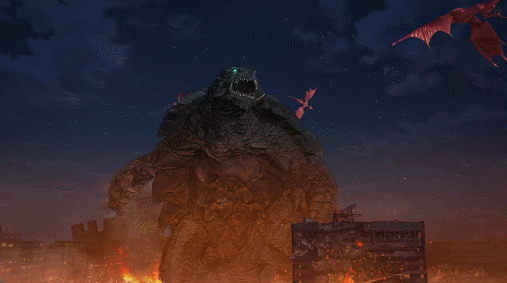
I was a bit nervous about GAMERA -Rebirth-; the animation looked dodgy and Netflix has a shaky track record with kaiju shows. I'm pleased to report this is the best entry in the genre that they've put their name on. Good characters, great action (brutal as always), and actual episodic storytelling that effortlessly weaves in elements from the Showa films beyond all the returning kaiju. Watch it immediately.
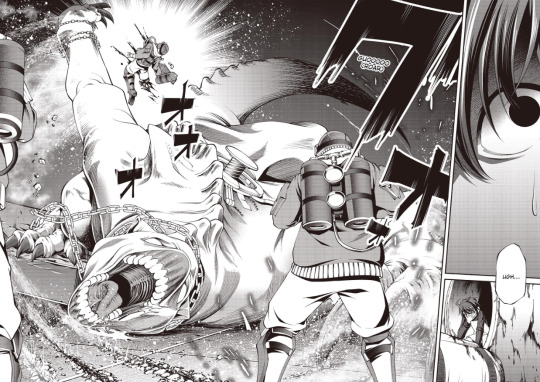
Tie-ins abound for GAMERA -Rebirth-: a two-part novelization, a manga adaptation, and a prequel manga that sheds some light on [UNBELIEVABLY MASSIVE SPOILERS]. That prequel manga (GAMERA -Rebirth- code thyrsos) is being published online for free in both Japanese and English. You can read the first chapter here.

In unofficial translation news, English subtitles for GAMERA.1999 (1999) and yokaipedia (2022) are now available. The former is Hideaki Anno's making-of documentary for Gamera 3: Revenge of Iris; the latter is a fun, child-friendly fantasy from Godzilla Minus One director Takashi Yamazaki with a big ol' centipede-dragon at the end. (It's also maybe the first Japanese kaiju film I've ever seen with a major Black character.) I haven't gotten to GAMERA.1999 yet, though from scrubbing through it, it seems like a lot of dialogue was just ignored by the translator. Shame, as that's one I've wanted for a long time.
youtube
We have a teaser for Monarch: Legacy of Monsters, as well as a premiere date for the first two (out of ten) episodes: November 17. (I am being showered with Media for my 30th birthday.) The big news from this trailer is that John Goodman is reprising his role as Bill Randa from Kong: Skull Island. I assume that's going to be through flashbacks and old recordings only, since he was eaten by a Skullcrawler in that one. We also catch glimpses of two new creatures, a dragon and a crab from what I can tell. The latter looks to be fighting a Mother Longlegs.
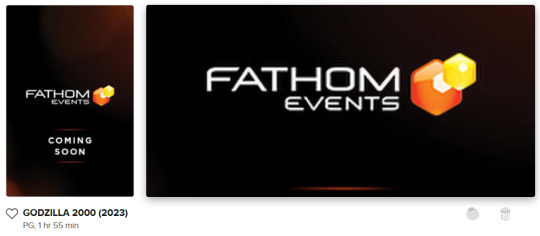
Fandango and AMC have added mostly-empty listings for Godzilla 2000 on November 1. Fathom Events screened Godzilla Against Mechagodzilla on November 3 last year; despite randomly showing Tokyo SOS back in March, I gather they're making a tradition out of Godzilla Day. Note that the listed runtime is longer than the film itself. Predictions for the program: another message from Keiji Ota, the 2022 Godzilla vs. Gigan short, and the Japanese version of G2K. Interesting that they're running the last Toho Godzilla film to receive a wide release in the U.S. exactly a month before Godzilla Minus One has a wide release of its own here.

Gamera isn't a meta-defining Godzilla Battle Line unit... but he's Gamera in a Godzilla game, so I've been using him in every match since I unlocked him. He's gearing towards demolishing flying units, with fireballs that deal more damage against them and knock them back. A pity that he's arriving well after those units were at their most dominant.
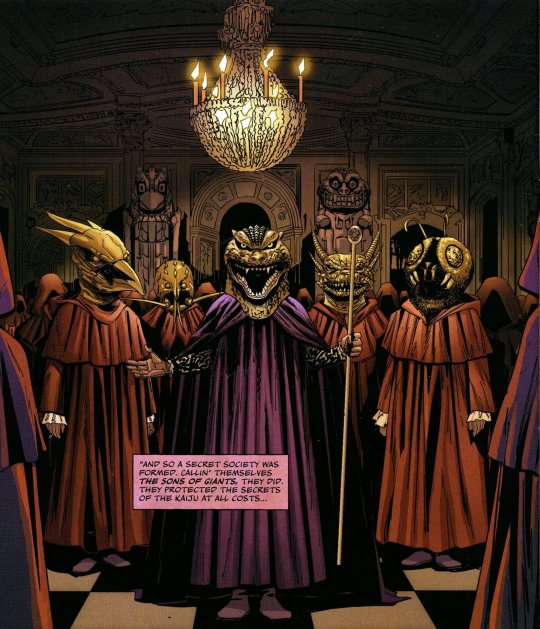
Godzilla: Here There Be Dragons #3 still isn't giving me much to write home about, but the kaiju cult creeping to the forefront intrigues. Also cool to see Ebirah in a starring role.
youtube
Marubeni, one of Japan's biggest general trading companies, put out a bizarre commercial featuring samurai, zombies, a meteor, and a refurbished GMK King Ghidorah. The ad now has English subtitles, and you can watch a Ghidorah-centric behind-the-scenes video here.
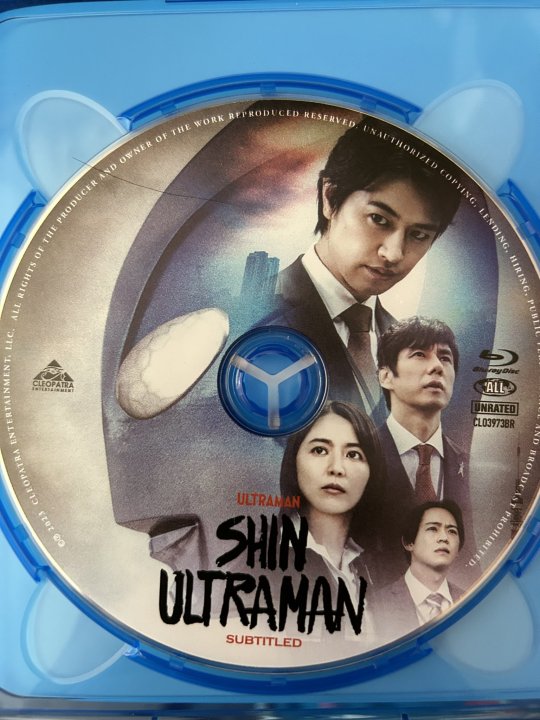
I cannot believe I have more Cleopatra Entertainment fuckery to report on with regards to their Shin Ultraman releases, but they're truly trying to take the "Worst Film Company of 2023" title from the members of the AMPTP. Their third attempt at a barebones disc is starting to reach customers... but the ones who already received the initial replacement disc are being told no more will be sent. @starestream is trying to figure out if they'll be selling the third edition on their site, since it seems buying it anywhere else is a gamble. (Physically, the third edition looks almost the same as the first two, set apart only by the "SUBTITLED" text on the disc.) Either way, it's another blow to a movie that truly doesn't deserve this.
91 notes
·
View notes
Text
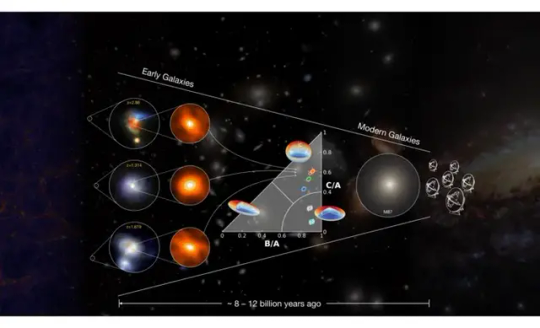
Astronomers witness the in situ spheroid formation in distant submillimetre-bright galaxies
An international team of researchers including The University of Tokyo Kavli Institute for the Physics and Mathematics of the Universe (Kavli IPMU, WPI) has found evidence showing that old elliptical galaxies in the universe can form from intense star formation within early galaxy cores. This discovery will deepen our understanding of how galaxies evolved from the early Universe, reports a new study in Nature.
Galaxies in today’s Universe are diverse in morphologies and can be roughly divided into two categories: younger, disk-like spiral galaxies, like our own Milky Way, that are still forming new stars; and older, elliptical galaxies, which are dominated by a central bulge, no longer forming stars and mostly lacking gas. These spheroidal galaxies contain very old stars, yet how they formed has remained a mystery—until now. The discovery of the birth sites of giant, elliptical galaxies – announced in a paper published today in Nature – come from analyzing data from the Atacama Large Millimeter/submillimeter Array (ALMA) on over 100 Submillimeter Bright Galaxies (SMGs) with redshifts dating to the “Cosmic noon” era, when the universe was between around 1.6 and 5.9 billion years old and many galaxies were actively forming stars. This study provides the first solid observational evidence that spheroids can form directly through intense star formation within the cores of highly luminous starburst galaxies in the early Universe, based on a new perspective from the submillimeter band. This breakthrough will significantly impact models of galaxy evolution and deepen our understanding of how galaxies form and evolve across the Universe. In this study, researchers led by Chinese Academy of Sciences Purple Mountain Observatory Associate Researcher Qinghua Tan, and including Kavli IPMU Professor John Silverman, Project Researcher Boris Kalita, and graduate student Zhaoxuan Liu, used statistical analysis of the surface brightness distribution of dust emission in the submillimeter band, combined with a novel analysis technique. They found that the submillimeter emission in most of sample galaxies are very compact, with surface brightness profiles deviating significantly from those of exponential disks. This suggests that the submillimeter emission typically comes from structures that are already spheroid-like. Further evidence for this spheroidal shape comes from a detailed analysis of galaxies’ 3D geometry. Modeling based on the skewed-high axis-ratio distribution shows that the ratio of the shortest to the longest of their three axes is, on average, half and increases with spatial compactness. This indicates that most of these highly star-forming galaxies are intrinsically spherical rather than disk-shaped. Supported by numerical simulations, this discovery has shown us that the main mechanism behind the formation of these tri-dimensional galaxies (spheroids) is the simultaneous action of cold gas accretion and galaxy interactions. This process is thought to have been quite common in the early Universe, during the period when most spheroids were forming. It could redefine how we understand galaxy formation. This research was made possible thanks to the A3COSMOS and A3GOODSS archival projects, which enabled researchers to gather a large number of galaxies observed with a high enough signal-to-noise ratio for detailed analysis. Future exploration of the wealth of ALMA observations accumulated over the years, along with new submillimeter and millimeter observations with higher resolution and sensitivity, will allow us to systematically study the cold gas in galaxies. This will offer unprecedented insight into the distribution and kinematics of the raw materials fueling star formation. With the powerful capabilities of Euclid, the James Webb Space Telescope (JWST), and the China Space Station Telescope (CSST) to map the stellar components of galaxies, we will gain a more complete picture of early galaxy formation. Together, these insights will deepen our understanding of how the Universe as a whole has evolved over time.
IMAGE: Schematic diagram shows how spheroid formation occurs in distant submillimetre-bright galaxies, and how this process connects to the evolution of giant elliptical galaxies in today's Universe. On the far left, we have RGB images from JWST (using F444W for red, F227W for green, and F150W for blue) showcasing examples from our sample of galaxies. The cyan dashed ellipse marks the concentrated region of submm emission, with zoomed-in views highlighting the ALMA submm images. Also shown is a classification of the galaxies' intrinsic shapes. The average shape parameters for our full sample (green ellipse), a subsample of submm-compact galaxies (orange ellipse), and a subsample of submm-extended galaxies (blue ellipse) are compared to local early-type galaxies (red ellipse) and late-type galaxies (represented by purple and cyan spiral shapes). Credit: Qing-Hua Tan
4 notes
·
View notes
Text
"When I started learning immunology, I stumbled across this curious type of protein complexes that form holes on the cell membrane. I didn't believe it at first because the idea of some protein that insert and create a physical opening on the membrane to leak out all the cellular contents is absolutely wild. To my curious young mind, it is a proper offensive weapon! There are two major types of membrane pore forming complexes: The Membrane Attack Complex (MAC) that is formed by the Complement system, and The pore forming complex by the Gasdermin protein family. The first clip is an example of the Gasdermin pore, specifically Gasdermin B, formed by the oligomerisation of multiple GasderminB proteins (PDB ID: 8GTN). The longer protruding part is where it inserts itself into a lipid membrane. When a cell is infected with pathogens like bacteria, the Gasdermin protein inside that cell is activated by Granzyme A released by Natural Killer cell. Gasdermin then inserts itself to the cell's plasma membrane and form holes. These holes lead to the release of inflammatory molecules and also cause the cell to burst open (pyroptosis, an example for this can be seen in one of my previous videos!), halting the spread of pathogens. Gasdermin B, however, is a special type of Gasdermin where they directly form holes on the bacteria's cell membrane, not the host cell! It is so far the only type that is known for doing this. The electron image at the end is taken from an interesting paper published in the journal EMBO entitled: Mechanism of membrane pore formation by human Gasdermin-D. You can really see the holes formed in the artificial lipid membrane! Go check it out! Pore forming protein complexes are now being explored as a therapy for essentially bursting open cancer cells too! How cool?!!"
-- I got permmission to share this from Bicosmos on instagram here, they also asked me to plug their YT as well if you wanna check out! They do a lot of cool videos on macrophages and cancer.
I was already aware of gasdermin but I never really thought much about it's use, it pokes holes in the cell, essentially killing it and stopping the reproduction of the pathogen inside it. Immune cells react very violently to the presence of dead cells as well, so it's content being spilled out attract them to the site of where this is happening. This also forces the pathogen out, helping the immune cells to engage with it, where they would not be able to if they were inside another cell.
4 notes
·
View notes
Text
Hi, I’m offering writing commissions now! I am offering short story length works (1,000 to 10,000 words) and while I can go over 10,000 for some works I will prefer to keep works under 10,000. My work is 1 cent per word with a minimum of 1,000 words. I’ll be taking commissions on Ko-fi and the link to my page will be at the end of this post and in my bio.
I’m a senior English major at the moment so my turn around time might be a little slow. I’m also (hopefully, I’m currently applying) going into grad school for Creative Writing in fall 2025 so turn around time will be a little slow at that point too. I have one properly published work (a short story titled Words to Use More Often in a short anthology titled Under the Skin) and one poem published in my school’s arts magazine. Please also note that I do have a learning disability that affects my grammar and spelling abilities so apologies in advance for any issues that may cause. I will have you look over the work before I send you the finished product to make sure it is what you wanted and isn’t filled with a lot of errors.
I Will Do -
Genre fiction (fantasy is my main genre but my published work so far is realistic fiction and poetry)
Established characters for shows/books/movies
OCs in an original universe or real world/realistic fiction stories of OCs
OCs in worlds from shows/books/movies
Shipping (OC x OC, Established character x Established character, Established character x OC)
I’m more than happy to write fics and backstory stuff for D&D characters. A lot of what I write in my free time is about my own D&D characters so I enjoy writing in that setting.
I Will Not Do -
NSFW/Smut. I’m not uncomfortable with a little steamy stuff but I’m not a good smut writer so I won’t offer that.
Extreme violence or gore, I’m not fantastic at writing physical fight scenes so violence isn’t something I can really do. I’m not comfortable doing extreme gore but some levels of gore is fine (mild depictions of injuries, blood mentions, mentions of past injuries/trauma)
Relationships between adults and minors
Anything that portrays things such as abuse, racism, or queerphobia in a positive light. I can write stories where characters face these issues but I will not write them in a positive or glorified light. I also will not use racist slurs.
For the most part I will not write stories set in worlds from fandoms I know nothing about or I do not like. This is mainly because I wouldn’t know enough about the world or plot of the original story to write something set in it. I might make exceptions for some things but if I don’t know the franchise/story the work you want takes place in I most likely won’t take it. I won’t do Hazbin Hotel or Helluva Boss because I do not like those shows for personal reasons so I’m not comfortable writing about them.
Some Rules and Extra Notes -
No posting my writing online without crediting me and no posting my writing to fanfic sites. I’m ok with you giving copies of the work I do to friends for free but don’t claim my work as your own or try to resell it.
I have the right to refuse service to anyone. If I’m uncomfortable with writing a particular prompt or a particular fandom I will refuse to write it.
I will try to complete the story as soon as I can but it may take a while to finish some things. I’m in college and disabled so I do have some things in my life that might prevent me from writing for a few days. I will keep you updated on my progress and let you know if I will be taking longer than expected to write a particular story for whatever reason. I am a particularly fast writer and have written 3000+ word short stories in about an hour or two so it should not take too long for me to complete the first draft of your story but I will keep you updated if it does.
What I Need From You -
Name(s) of the character(s) you want the story to be about, a description of how they look (and a pic of them if you have one), a description of their personality, and their relationships to other characters.
The genre you want the story to be in and your preferred word count if you have one.
Tropes you enjoy and would like me to include.
Tropes you don’t like and anything you don’t want me to add.
Any inspiration you want for your story. This can be anything from a music playlist to a Pinterest board to a different show or story you want emulated.
If you have a preferred date of compilation let me know. I will try to get a first draft done as soon as possible.
Be as detailed in what you’re interested in as you can, even if all you’ve got is character names and a vibe.
I will need some form of contact to message
My Ko-fi link - https://ko-fi.com/beeribasschultz/commissions
2 notes
·
View notes
Note
✒️ please!!
Send me a ✒️ and I'll pick a poem I think you'd like
After flipping through my notebooks I decided to go with my first instinct for you, which was "A Toast to the Alchemists" by Laura Gilpin. This poem hasn't been published online officially, so they're aren't a ton of sites that have it that I could find with a quick Google search. However I've attatched photos of a reddit post with it along with my version in my journal.
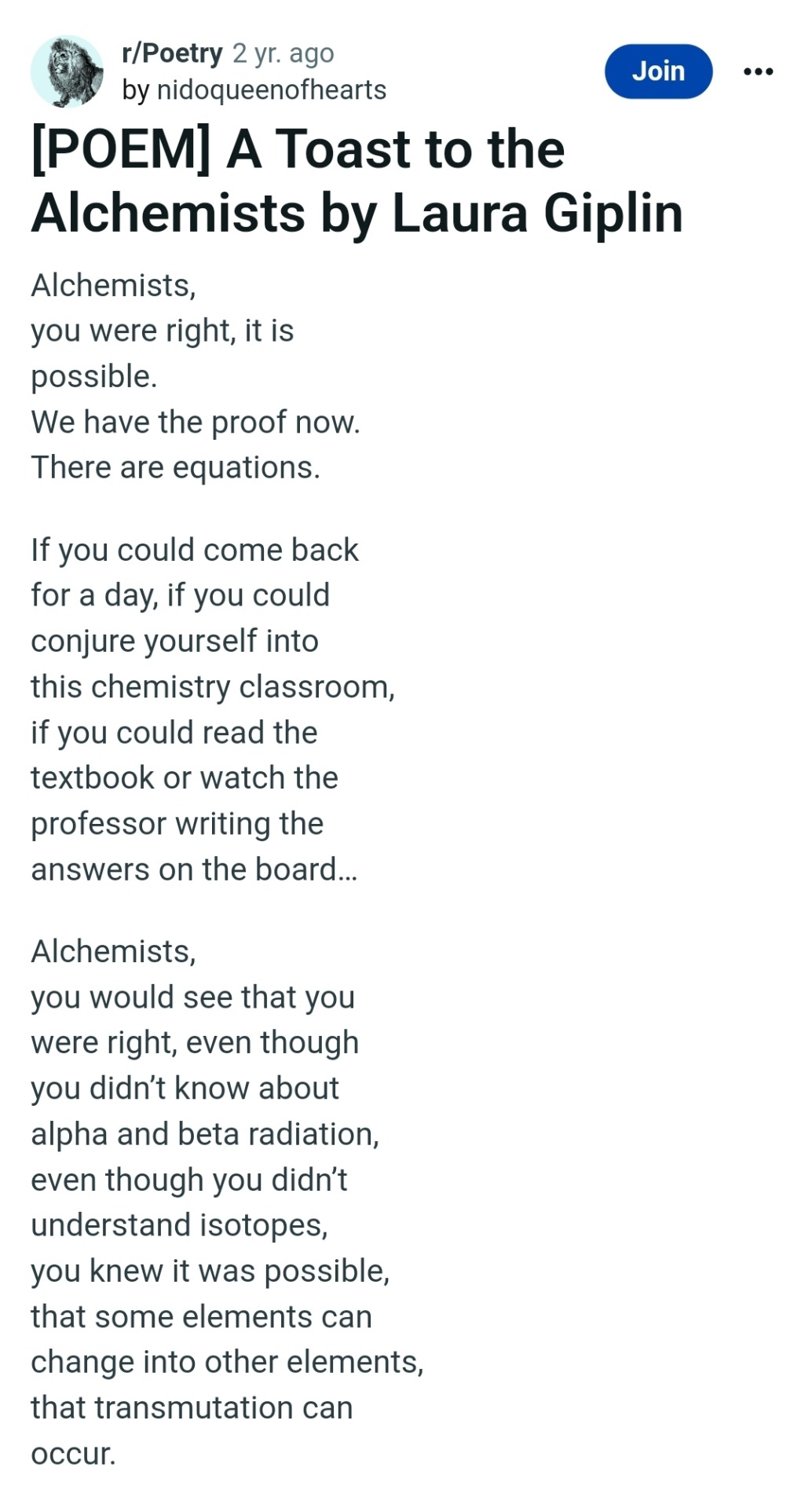
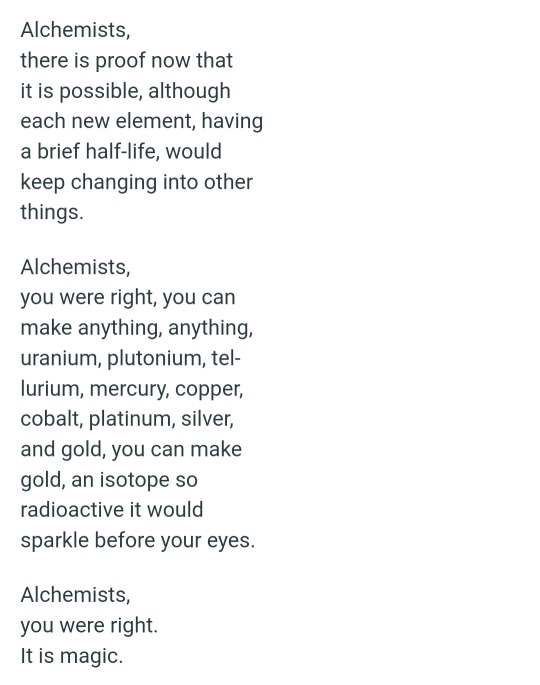

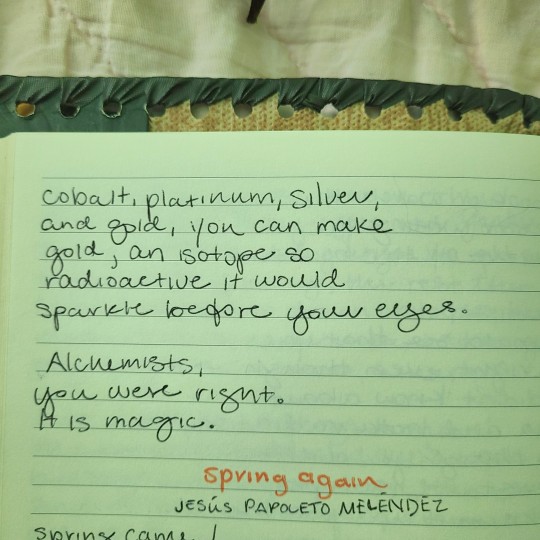
I picked this poem because of its themes of time and the passage of time, as well as magic and giving emotional significance to the most mundane and clinical of things (atoms and elements). In other words, taking magic from the world around us, especially through a lens usually seen as lacking wonder or whimsy. Also vibes, I mainly did it based on vibes.
Some other poems I considered in my search/additional recommendations are listed under the cut:
If you liked the writing of this poem, and haven't read it already (or have) I definitely recommend "The Two-Headed Calf" by Laura Gilpin. It's by the same author and is her most famous poem and is fairly well known and also soooooo good. So good.
Poems with similar themes:
Poems with similar themes to "A Toast to the Alchemists" are
"Dusting" by Marilyn Nelson 💘 (literally cried to this. To be fair it was 10 minutes after I finished the HDM finale so it was mainly because of that but still. Great poem.)
"The Sciences Sing a Lullabye" by Albert Goldbarth
"Ozymandias" by Percy Bysshe Shelley (90% sure you've read this one its the time theme but inverted and it's great if you haven't)
Rejected picks/Poems that gave me Anu vibes (many for no particular reason):
Poems by Ted Kooser for some reason??? NO idea why they're very different from the ones above but some of my faves are "Selecting a Reader", "In a Country Cemetery in Iowa", "The Constellation Orion" and "Flying by Night" (I'm v much questioning this pick now but I'll keep it up here just in case)
Honestly a bunch of random unrelated stuff was popping out at me ("Listen" by Miller Williams, "Cartoon Physics, Part 1" by Nick Flynn, "Snow" by David Berman) and like a million billion more which I all got from the same anthology (Poetry 180, edited by Billy Collins) so if you want to read a bunch more poetry, based on vibes alone, I'd say look for the book, the website, or the sequel. The poems from that book aren't too similar to the one above but it's really one of two books I generally recommend people right off the bat (it was my lit teachers favorite lol) because it's meant to get young adults and teens into poetry and introduce contemporary poetry in general. Idk how much poetry you've read whatever but even if you aren't new to it it's still a good compilation of late 90s/early 00s poetry that makes you think but isn't super long/totally incomprehensible
Anyways that got WAY longer than I anticipated or anyone probably wanted but poetry is an obsession of mine and recommending poetry is much more complicated and harder that it looks, even for the people you know best in the whole world AFTER interviewing their opinions on poetry, not to mention how difficult it would be for internet friends on tumblr. But anyways there's a couple poems, I got the vibes as close as I could with the poems I had on file. (Although i do feel like I'm missing something big 🤔) Anyways thanks for the ask Anu! Hope you thought my pick was alright!
#and please for the love of god dont feel pressured to read ANYTHING on here i spend hours and hours reading poems so when i rattle off names#like that its very much me bouncing along like a frog eating skittles hopping from poem to poem to poem#based on vague vibes and feelings#also also also i already knew this when i made this ask game BUT. recommending poetry is like trying to juggle with your eyes closed because#you just KNOW you just KNOW there is a group of perfect fall in love poems out there but theres a million factors you have to take into#account to find them. like theres theme theres rhyme theres rhythm theres style theres readability/directness#and you have to try and predict someones opinions on all of that while also trying to gauge their level of patience on topics like#age of poem clarity use of standard language and spelling experimental features and line breaks#when a use of any of those they dont like can turn them off a poem entirely#like we were asoue fans together so youd probably like something with ambiguity and could tolerate a more classical look#BUT then comes in the length factor and also a bit clarity plus we have to remember theme and i cant think of any poems that fit that idea#with a theme you would like that i would feel comfortable recommending (because some poems are good but also difficult)#and i LOVE difficult poems theyre my besties but i always hate them during the first 3 reads at least and who has time for that if you dont#have poetry brain disease like i do#anyways. thats a very long way of saying. i tricked you into asking me to ramble abt poetry mwahahahahahahaha#also if anyone out there feels like theyre someone who rambles a lot about their interests to others and can at times feel a little guilty#abt that the poem “To The Sea” by Anis Mojgani talks a bit about that from an outsider pov#blah#poetry tag#answered#jacobsnicket
8 notes
·
View notes
Text
Top Trends in SEO for PropTech That You Should Know
In the fast-paced world of property technology (PropTech), staying ahead of digital trends is crucial for visibility and growth. As the PropTech sector evolves, so does the need for smart, targeted search engine optimization (SEO) strategies. With the right approach, businesses can attract high-intent traffic, enhance credibility, and stay competitive in a dynamic digital marketplace. Here are the top SEO trends that are shaping the PropTech space right now.

Local SEO Is More Important Than Ever
As PropTech businesses continue to bridge the gap between online platforms and physical properties, SEO for PropTech—especially local SEO—has become a major focal point. People searching for real estate or property services are often looking for results in specific locations. Optimizing for localized keywords, creating location-specific landing pages, and ensuring accurate business listings across directories can drastically improve search visibility. Adding structured data like local business schema also boosts the chance of appearing in local packs and map results.
Voice Search Optimization
The rise of voice-activated devices has changed how people search online. Many prospective buyers or renters now use natural language when asking questions via smart speakers or smartphones. This shift calls for a more conversational keyword strategy in PropTech SEO. Phrases like "best apartments near downtown" or "property prices in [city] this year" are increasingly common. Optimizing content for long-tail keywords and answering asked questions clearly and concisely can help capture this growing search traffic.
AI-Powered Search and Content
Search engines are getting smarter with AI tools like machine learning and natural language processing. These tools prioritize content that aligns with search intent, not just exact keywords. For PropTech companies, this means writing content that genuinely addresses user questions, concerns, or interests—such as market insights, neighborhood guides, or tech updates in real estate. A thoughtful, user-first approach not only helps with SEO but also builds trust and authority in the industry.
Mobile-First Indexing
As mobile usage continues to dominate internet access, search engines are prioritizing mobile versions of websites when determining rankings. A mobile-responsive site is no longer optional—it's essential. PropTech platforms need to ensure fast load times, intuitive navigation, and accessible design across devices. Since many users browse property listings or market data on their phones, creating a seamless mobile experience can reduce bounce rates and improve engagement.
Quality Backlinks Still Matter
Backlinks remain a foundational part of SEO. However, it's not about quantity—it's about quality and relevance. PropTech businesses benefit most from backlinks earned through informative, well-researched content shared by credible sites. Publishing thought leadership articles, detailed case studies, or useful data analysis increases the likelihood of earning backlinks naturally. Partnering with related industries, such as construction, architecture, or sustainability blogs, can also enhance a site's authority.
Video Content Optimization
Video is becoming a central element in real estate marketing, and its SEO potential is growing. Search engines increasingly prioritize video content in results, especially for tutorials, property walkthroughs, or trend forecasts. Optimizing video titles, descriptions, and transcripts with relevant keywords helps increase visibility. Embedding videos on key landing pages can also improve time-on-page and user engagement—two signals that positively impact rankings.
SEO for PropTech is essential as the space is booming with innovation, and SEO strategies must evolve accordingly. By embracing these trends—local SEO, voice search, AI-driven content, mobile optimization, quality backlinks, and video marketing—companies can position themselves for long-term digital success. Staying ahead of the curve not only improves online visibility but also builds a strong, sustainable connection with potential clients in the digital property market.
0 notes
Text
[excerpt from “Courtship Behaviors of the Southern Coastal Husbro” chapter 6 (final chapter)]
---
[published in Slate.com]
The Un-Couple, Coupled
by Evan Buckley, guest contributor
Two years ago, I wrote an article for this site about my relationship with my best friend, Eddie. He and I had decided to become platonic domestic partners, share a household, raise his son (later our son, I adopted him soon after we entered this arrangement), and form a family. We were not romantically involved. We were not physically involved. We just wanted the security, support, and comfort of sharing our lives with the person who knew us best.
This concept seemed to strike a nerve. The article was shared, tweeted, discussed, and in some cases, doubted. I did an AMA on Reddit shortly after it was published, and was both flattered and mystified by the level of interest in the idea that two straight dudes who were just friends could commit to each other for life. In the many discussions that followed, we found out that this idea was not as unusual as it may have seemed. I’ve heard from so many couples (and groups of more than two) who have chosen this kind of relationship to form the basis of their lives and give them what they need to be happy.
It sure gave us what we needed. The years I spent with Eddie as his domestic partner (or “husbro,” as one of our friends likes to call us) were some of the happiest of my life. I’ve never felt so safe with another person, so valued, and so content.
I’m writing this follow-up article partially upon request (we get frequent emails asking how we’re doing) and partially because I wanted to share it with readers who felt seen by the first one, because our platonic domestic partnership has come to an end.
Whoops, we fell in love.
To those who already thought this was the case, or predicted that it would happen, well, congratulations. If you had a bet on it, spend your winnings on something frivolous. To those who felt validated that we were making a queerplatonic relationship visible, and making it work: you and your relationships are still valid, and still awesome. The fact that we failed at being platonic partners doesn’t mean that such a relationship is doomed to fail, it means that we were.
I definitely had some guilt that I’d “betrayed” this concept for which I’d been such a visible torchbearer, but Eddie says that my first responsibility is to myself, my own happiness and mental health, and to him and our family. He’s right.
If you’re thinking to yourself “wow, I could have sworn he said they were both straight” you’re correct. Sexuality isn’t an either/or situation, it’s a gradient. I am not the first person to experience an evolution of my sexuality, and neither is he. I’m not comfortable labeling myself, or him, but I can say that however I’m wired, it allows me to have a fulfilling, amazing, and physical relationship with a man I love very deeply, and for that, I’m grateful. If the rest of the world would like to call me a gay man, or call us a gay couple, that’s fine. That’s none of my business. I plan on spending the rest of my life happily married to Eddie (we got engaged a few weeks ago), so it’s sort of irrelevant, anyway.
Our son is over the moon, although I suspect the biggest part of that is he no longer has to share a bathroom, since Eddie moved into my room. Our friends and family are busy bombarding us with wedding suggestions (no, Hen, we are not having a destination wedding in Iceland) and we are debating how long we can wait to buy our son his new suit for the ceremony so he won’t grow out of it too quickly. We still work in the same firehouse and so we spend almost all our time together, but I still can’t wait to get home to see him and hang out with him. I never had any confidence that I would find happiness in life, or that anyone would ever volunteer to spend it with me, but Eddie has done so, repeatedly, and joyfully. I can’t wait to be his husband, and for him to be mine.
If my earlier article helped anyone out there discover a new kind of relationship, or realize that something they never imagined was possible, I’m glad. If anyone is happy now because of what I shared with you, I couldn’t ask for a better reward for writing it. If this update makes you feel sad, I understand. But our domestic partnership was valid and worthwhile on its own merits, not just because it led to more. We had an amazing, cooperative, and fulfilling life together long before our first kiss. Just because it changed, doesn’t mean it wasn’t real.
---
Read the whole fic series here on AO3!
#buddie#buddie fic#queerplatonic#madlori's fic#husbros#9-1-1#9-1-1 fanfiction#evan buckley#eddie diaz
25 notes
·
View notes
Text
DA4 Lead Producer Scylla Costa’s BIG Festival talk, “Challenges of Dragon Age production during the pandemic”, can currently be rewatched on YouTube here starting roughly at timestamp 8:57:02 after a lil presenter blurb/intro. It’s 1 hour long. When it was streamed live, there was an English translation ‘voiceover’. There isn’t in this vid, however I want to post the link for Portuguese speakers, and also it’s neat for everyone to be able to see all the slides he presented with for themselves in context.
I don’t know if an English-language version will get put up so I’m sharing the notes I took during the talk below, in case anyone’s interested and because I might as well since I wrote them. The rest of this post is under a cut due to length.
Edit: Found a place to re-watch the English version of the talk
(Quick note: I didn’t note down everything, mostly things that caught my interest, so this isn’t exhaustive, and when I was watching I was real tired, so pls bear that in mind and don’t take these notes as bullet-proof 100% accurate gospel or direct quotes. If you watched it and think I’ve written down something wrong/misunderstood, let me know and I’ll fix. Also if you’re a Portuguese speaker and I’ve gotten something incorrect or missed something important etc, again just let me know.) **
** Edit: I’ve now gone through my notes while watching the talk again. I’ve filled in some of the gaps (although they still don’t cover everything said) and so forth, and now I’m no longer worried about there being possible errors in this post.
-----
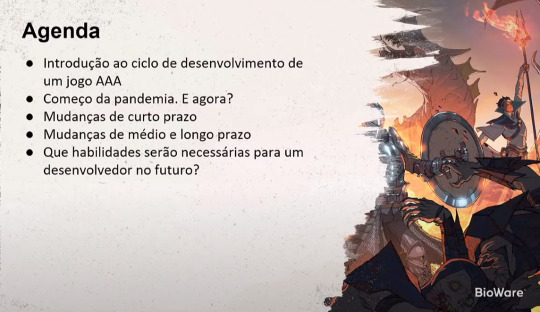
For some context, this slide contained the breakdown of the talk’s structure. Bear in mind there are other slides present in the talk than the ones I’ve posted here, I didn’t include caps of all of them, just ones which were of note to me.
In the talk, chief Producer Scylla goes over challenges of DA4 production during the pandemic. He discusses the adaptations - necessary skills and learning from remote work - and he ponders on the future of teamwork.
After the launch of ME3 he became a producer, all his MMO and other experience helped a lot. He was on DAI for 3 years and MEA for 9 months, then Anthem. Today, on DA4, Scylla and another Lead Producer were the heads of the whole project, and there is his boss is the Executive Producer Christian Dailey.
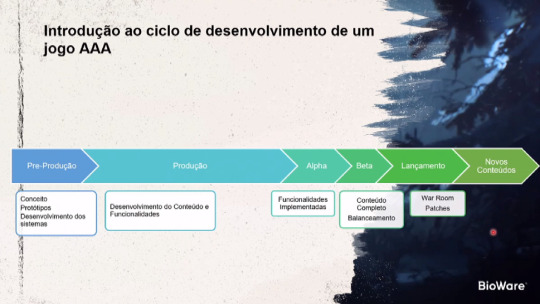
^ the usual AAA game development cycle (brief introduction)
AAA games are games that are launched for several platforms simultaneously.
In BioWare’s case, the pre-production phase of the game development cycle can have from 5 - 30 people, and up to almost 60 people when they’re just about to go through the gate to production.
In the pre-production phase, they go through the game’s concepts and prototypes and start developing systems. They seek the game’s concept and focus, and its key features. They do lots of market research. In the case of BioWare, all their games are strong in narrative, so they have lots of tools related to game narratives and supporting the development of a narrative (cinematic design, dialogue system etc) that get focused on in this phase. Other parts of the team such as writers and cinematic design need these systems to do their own roles.
In BioWare’s case, the pre-production phase through to launch can take 4 - 6 years, but it does depend on the size of the team during development.
With regards to Dragon Age 4, they were coming close to the time when they would shift from pre-production to the production stage when the pandemic hit.
During the production phase is when the development of content and features takes place, with the systems mostly already existing from the pre-production phase. A few new systems may be developed in this phase. In the production phase is when things start escalating, and the team really starts growing, to like 2- or 3-fold the prior pre-production phase size.
(DA4 is currently in the production phase.)
In the alpha phase, features have to be fully implemented and systems all have to be running / working. All the game features should already be in the game by now. They test from pre-production onwards, but this phase is when they run heavy technical tests with lots of players trying to play at the same time. In the beta phase, the idea is that you should now have full content and that now you’re balancing it and running more and lots of different tests with players before launch. There are final tweaks and then the final launch, when in the weeks prior to launch, all the different business units and areas e.g. marketing team, technology team, publishing team, get together once a day and all of the game’s issues are reported and brought to the table to be prioritized. Then they decide the next steps re: these issues (this is known as ‘the war room’).
After the launch there are usually patches like day zero patches and other patches, this being standard industry practise. The last stage is the new content stage where there are DLCs and a game with more content.
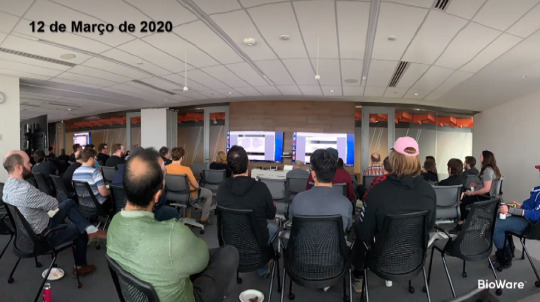
On March 12th 2020, the team gathered to review the DA4 story in the new office. Everyone was very excited. (They had spent over 10 years in their last building and had noticed that with the team growing they needed more space. In August 2019 they found the new studio in the city center.)
Anyway that evening, they got an email from the CEO which contained instructions and said that due to the pandemic, they should from now all start working remotely. They had known that this happening was a possibility so they had been planning on how to have all the devs working from home, but initially less than 50% of the devs were able to work from home successfully/efficiently due to various issues e.g. you need a VPN to be able to log in remotely to do your job normally, varying home office setups. The day after this, the office was basically deserted, except for Scylla, the IT infrastructure people and one or two odd devs.
Scylla was part of the team that was working on allowing the devs to work from home. They first started looking at the short-term changes they needed to make to allow this.
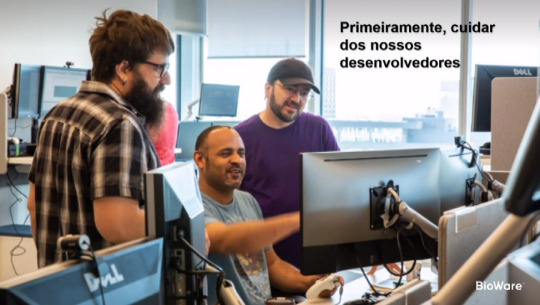
“First, take care of our developers”.
When the pandemic first hit, their and Scylla’s [as Lead Producer] first priority was to look after the devs. Many of them are parents (schools and day-cares were shut, children were studying from home), others have relatives living with them, others have other personal circumstances which of course need to be taken into account when it comes to assessing what needs to be taken into consideration for this new scenario. So, they looked at each dev on a case-by-case basis in order to evaluate, speaking to each one and asking them what they could do to support them.
One of the first changes/adaptations they could implement was flexible working hours and flexibility around deadlines. Generally speaking the devs got a lot of support, EA was really good and really supported the devs especially in the first months of the pandemic (and they are still supporting them). Initially not all devs had suitable office spaces at home, some were working from the living room from laptops or at the kitchen table. The whole covid situation basically just happened over night and nobody was really ready to deal with that change. So their first step was to enable their devs to work remotely. As a producer, Scylla’s main task is to communicate with the team such as via a number of daily meetings. He doesn’t depend so much on powerful hardware.
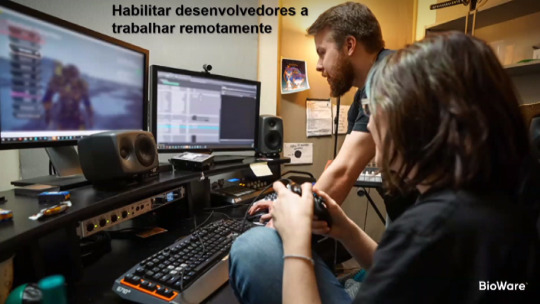
“Enable developers to work remotely”.
This slide shows some of a BioWare audio team. Different teams have varying and specific needs in order to do their jobs and therefore in order to do them remotely. For example, the audio team need good-quality speakers and amplifiers, while the lighting and art teams need other specific equipment such as tablets and large screens. So there was a lot of work they had to do to go through each dev to understand their individual needs and what needed to be done for them. ‘Could they download the builds? Did they have the right performance [tech-wise]? Could they submit their changelists, their codes to the server?’
Some devs needed a more powerful internet connection as it would take 6-8 hours to download a build (some devs live rurally). Some needed a lot of cable, as they were working far away from their routers (sometimes up to 50m). As time went by things got better and better.
The chair devs work from is also important; a kitchen able chair etc is not suitable to sit in for long-term desk work, possibly leading to health issues like back ache and blood circulation problems in the legs.
Every 3 months they had money given to help devs buy new mice, keyboards, monitors - anything they needed really in order for their office setting at home to be improved. For a while, because lots of people [generally, in society] were needing and buying them, it was quite hard to buy things like webcams and microphones.
On mid- and long-term changes:
In terms of DA, we have to look at this from 2 perspectives, the change in the personal and the professional environments.
As a consequence of working from home, people tend to be less active during the day (even in an office, you go between meeting rooms, up and down stairs etc). Physical activity supports life quality and therefore work quality. Scylla noticed that he began to feel listless and such, and found that he needed to change his routine that he had initially developed when he started working from home, for example; having a normal start time (as in, have a semblance of structure in your day as if you were still working in the office site), get dressed at the normal time, not having meetings over lunch etc. This wasn’t just him, lots of other devs encountered this and had this experience too. Devs which adapted faster had better productivity and became more productive faster.
Scylla bought a stand-up desk which he can raise up and down, and at meetings he would be delivering a talk while standing or even while walking on a treadmill. Other devs also got stand-up desks. He tracked his body’s data on a Fitbit. These sorts of things helped improve physical and mental wellbeing. Other devs did similar things, like starting going out for jogs or began practising yoga. Essentially, everyone needed to make changes to their daily routine in comparison to what they had been doing prior to the pandemic.
The pandemic has been a thing for over a year now. In their location, every couple of weeks a new restriction is put into place or a rule is changed, and every two weeks there’s a new thing that you can and can’t do. Scylla also started moving around his property. He worked on his desk, fixed it up and painted - taking up a new hobby. Other devs picked up new hobbies too. These are good ways to be active and also to be somewhere else, i.e. to break up the working day and not be spending it all in one home office-type location. Scylla found that when he made these sorts of changes to his routine to improve his lifestyle, the data output by his Fitbit as indicators of his health/wellbeing etc improved, e.g. number of steps taken in a day, heartbeats per minute while at rest. As stated many of the other devs went through a similar process.
On the professional side of things:
They had to improve remote delivery of builds. Accessing things from home as a dev requires a VPN. They need to download a build every day and then upload it to the server after making their changes to the game. They had to work with infrastructure and research other tech, such as streaming tech to allow remote console access, in order to better facilitate this process. For remote access, they also had to work on adapting communications channels.
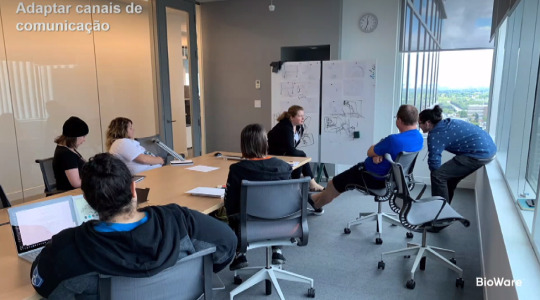
“Adapting channels of communication.”
In this slide, the team are working on the storyboards. Before you can implement motion capture & performance capture, you have to ‘run the storyboards’ like this. These are small illustrating drawings which reflect the drafts and are meant to quickly reflect the intention of the scenes that are to be built. Before the pandemic, the team would go to meeting rooms like this, sit down, talk and interact in person. After the pandemic, the question became ‘How do you do this over Zoom?’ You can, but it’s not quite the same; it’s harder to see peoples’ expressions, some people are embarrassed speaking over Zoom etc. Therefore they had to adapt their communications systems, and unlearn the ways in which they developed before in order to relearn and learn new ways of communicating.
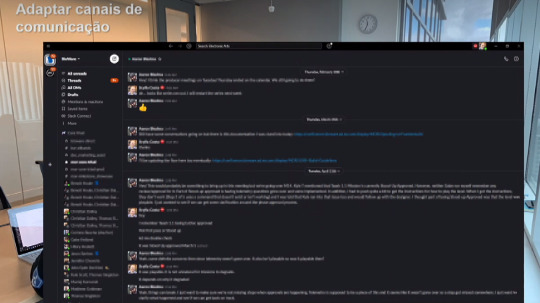
Slack was a tool that they adopted on this front. Communications channels can be confusing on Slack, so there was a need to develop structure. For example, how quickly should someone reply (as a recommended convention for the purposes of work)? They had to define the process/procedures for the channels so it was clear for the team as a whole how it would all flow (this is important especially if you have a team with say 30 people or as a whole hundreds of people). Before the pandemic, they had stand-up meetings where they’d go around in a circle every morning and talk about their activities - what they’re going to be working on, any roadblocks they had encountered etc. The question arose ‘How do you replace these?’ They ended up doing Slack messages at a certain time of day and updating their statuses with some details on what they’re working on and color-coding (green - fine, yellow - need help, red - busy/blocked out).
Another issue that they faced was unforeseen - the number of meetings that devs were having really shot through the roof. When there wasn’t a good structure of communications channels, any conversation would become a meeting. Everybody began scheduling meetings left and right, and at the end of the day they would have little time left in which to actually work on their to-do lists. Hence, they had to work with the team to really analyze and be very pragmatic. ‘Which meetings needed to happen? Which didn’t? Is a specific meeting really necessary? Which meetings should be recurring? What can be done over Slack?’ This guideline had to be given to the team to help, and it improved things a lot. The number of meetings decreased a lot and they got more effective. For example, by making sure to set an agenda for meetings beforehand, and by having meeting notes (then a dev who didn’t really need to be at a meeting could skip attending and just quickly review the notes output after instead). They also decreased the standard length of meeting times from the default Outlook blocks of 1 hour and 30 mins to 55 mins and 25 mins respectively. This 5 minute change gave devs time for things like bio breaks (also 4 hours in a row at a computer in a home office with one meeting after another just isn’t good for a person).
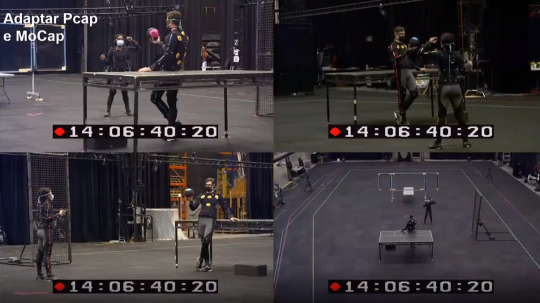
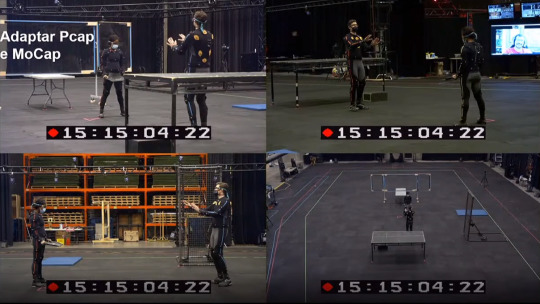
“Adapting p-cap and mocap”.
On content:
From a content point of view, the most difficult thing in terms of the pandemic was adapting p-cap and mocap (performance capture and motion capture). They hire actors and it’s a large studio. The pandemic meant big limits to what they could and couldn’t do. The actors had to be masked and 5 meters apart in distance (although it doesn’t look like it in some of these shots due to angles). Also there could be no other person around in the studio - only the actors. The directors instead would ‘patch’ in remotely on big screens (you can see this in the second photo in the top right).
Before the pandemic, they felt that they wouldn’t be able to do p-cap or mocap properly remotely, as the directors would usually stand right next to actors giving guidance on their performance. The techs would also usually be near. But they adapted! The keyword is adapting, changing process. It’s harder and it’s different, but it is possible, and people start rethinking what is possible. What was said to be impossible before now is possible.
P-cap differs to mocap in that it also captures voice and facial expressions.
On the future of work after covid:
There will probably be more working from home and more flexibility for workers e.g. being able to work say 3 out of 5 days from home. It does depend on what a dev’s specific job is however. For example, the audio engineers require lots of specialist equipment and said equipment is of higher quality and quantity in the office. So, depending on role, devs might be working more often or less often from home.
Another development is that lots of devs are moving house. In lockdown etc people started reassessing what’s most important in life. Some are moving further away from the studio to get a cheaper rent or for example couples who both needed an office space to work from home from but their current place only had one area. Others are moving closer to nature for a better quality of life, and still others have other different reasons for doing so. Over 10 devs that he knows in fact have recently moved, including Scylla himself.
The pandemic changed certain skills being used by people on a daily basis. Scylla used as an example of this one of his soft skills, being able to tell from looking/interacting in-person with someone if they are stressed out. Obviously it’s less easy to tell if someone is stressed out when you’re remote, so you adapt different ways of checking in with people in the new situation. To continue carrying out his role as Lead Producer, he began checking in with his team pro-actively on the new comms channels and asking how they were doing.
Also, now that companies are more open to working remotely, there is going to be increased competition for hiring devs. They saw both sides of this coin at BioWare. They were able to hire devs from many places that they couldn’t hire from before e.g. Montreal, Vancouver, the US, as there’s less need for devs to relocate to Edmonton or Austin. This opens up opportunities to hire really intelligent and skilled people that they would not have had access to before.
Question and answer segment:
The pre-production phase has been concluded. They’re in the production phase.
They are not giving out a lot of details yet but Scylla is really excited as a big fan of the whole series. He thinks that with DA4, they will have the opportunity/possibility to launch the best story out of all DA games. He feels that the characters they’re making are amazing. He’s dying to say more but can’t.
When you work from home you need to keep your team as productive as possible. During the pandemic, when people started working from home, they noticed that some people became more productive and some people became less productive. They were analyzing it on a case-by-case basis so as not to make assumptions. They were interested in seeing what they could do to help. At the beginning of the pandemic, they were looking at the devs as people and seeing what they needed.
Production of DA4 still needed to continue during the pandemic because they want to be able to launch the game.
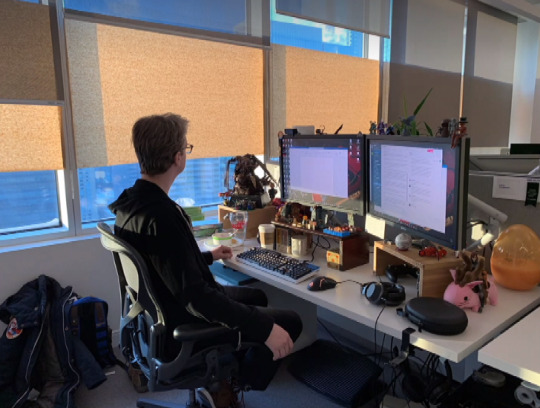
This slide shows a writer. Writing is an example of a role which is more able to work from home easily.
Their productivity did go down in the first month of the pandemic. After adaptations, some people then became more productive than they were before (this was role and personal situation-dependent, examples of this being artists and coders who were able to art and code at home without being interrupted, thereby being able to produce more). Covid has affected productivity in general, but this is part of our new reality. They have adapted and adjusted some deadlines. They have enough data (Scylla LOVES data) now to understand how long it will take them/how long they’ll need to launch the game. They have always had historical data for this purpose, but they’re doing more of this sort of thing now to ensure that they are doing things at the right time.
Remote hiring opens up the door to more talent joining, so if someone has talent geography will hold them back less. Some companies though may choose not to hire people from other countries due to labor issues, cumbersome legal aspects, time zones. But even in such cases there are activities for example that can be carried out while the rest of the team is asleep such as testing or working on the build, or there are cases where those companies still will want to hire a specifically/highly talented person even in spite of the potential legal aspects and so on.
On mental health: People were affected. There is the mental, physical and social impacts of the pandemic situation on people. EA supported them during the pandemic in terms of their mental wellbeing, there are specific companies (services offered, speaking to a therapist) that they can contact if they need something or help. EA had always been good at supporting them with this sort of thing but this has improved further during the pandemic. Another change was that they could/can take a couple of days off if they needed/need to because of the pandemic e.g. to take care of children, who were obviously not at school at the time. As a producer he had to be very mindful of all of this. How much they were monitoring peoples’ wellbeing really went up during the pandemic.
A question that was asked - in terms of DA4′s storybeats, is there anything in there that they decided to change due to the pandemic as it wouldn’t be sensitive or appropriate to include anymore, for example a plague plotline or something? Scylla’s answer is that DA and ME are games in which they try to have narratives that are relatable, which include things which people will identify with, so that players understand what characters are going through etc. Nothing in DA4′s plotline/storybeats has been changed (in the frame of this question, relating to the pandemic), as it didn’t have anything in it that could be specifically or a directly connected to a pandemic-type situation or anything. Of course the DA story has Blights and the Taint, but these are different & fantastical things and existed long before the pandemic situation. So this wasn’t the case with DA4 and there was no need to change anything, but this has happened to other games where they decided to change a storyline due to a strong correlation with something in the real world.
There were then concluding/closing remarks. The message he wants to send is that a crisis will always spark opportunities. Look at a crisis and try to see how you can grow.
-----
[☕ found this post interesting or useful? my ko-fi is here if you feel inclined. thank you 🙏]
#dragon age 4#the dread wolf rises#da4#dragon age#bioware#video games#covid mention#long post#longpost#wanted to write these up properly and post them yesterday but wasn't able to#mass effect#anthem
106 notes
·
View notes
Text
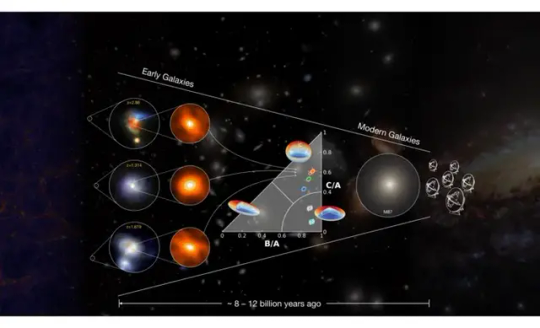
Astronomers witness the in situ spheroid formation in distant submillimetre-bright galaxies
An international team of researchers including The University of Tokyo Kavli Institute for the Physics and Mathematics of the Universe (Kavli IPMU, WPI) has found evidence showing that old elliptical galaxies in the universe can form from intense star formation within early galaxy cores. This discovery will deepen our understanding of how galaxies evolved from the early Universe, reports a new study in Nature.
Galaxies in today’s Universe are diverse in morphologies and can be roughly divided into two categories: younger, disk-like spiral galaxies, like our own Milky Way, that are still forming new stars; and older, elliptical galaxies, which are dominated by a central bulge, no longer forming stars and mostly lacking gas. These spheroidal galaxies contain very old stars, yet how they formed has remained a mystery—until now. The discovery of the birth sites of giant, elliptical galaxies – announced in a paper published today in Nature – come from analyzing data from the Atacama Large Millimeter/submillimeter Array (ALMA) on over 100 Submillimeter Bright Galaxies (SMGs) with redshifts dating to the “Cosmic noon” era, when the universe was between around 1.6 and 5.9 billion years old and many galaxies were actively forming stars. This study provides the first solid observational evidence that spheroids can form directly through intense star formation within the cores of highly luminous starburst galaxies in the early Universe, based on a new perspective from the submillimeter band. This breakthrough will significantly impact models of galaxy evolution and deepen our understanding of how galaxies form and evolve across the Universe. In this study, researchers led by Chinese Academy of Sciences Purple Mountain Observatory Associate Researcher Qinghua Tan, and including Kavli IPMU Professor John Silverman, Project Researcher Boris Kalita, and graduate student Zhaoxuan Liu, used statistical analysis of the surface brightness distribution of dust emission in the submillimeter band, combined with a novel analysis technique. They found that the submillimeter emission in most of sample galaxies are very compact, with surface brightness profiles deviating significantly from those of exponential disks. This suggests that the submillimeter emission typically comes from structures that are already spheroid-like. Further evidence for this spheroidal shape comes from a detailed analysis of galaxies’ 3D geometry. Modeling based on the skewed-high axis-ratio distribution shows that the ratio of the shortest to the longest of their three axes is, on average, half and increases with spatial compactness. This indicates that most of these highly star-forming galaxies are intrinsically spherical rather than disk-shaped. Supported by numerical simulations, this discovery has shown us that the main mechanism behind the formation of these tri-dimensional galaxies (spheroids) is the simultaneous action of cold gas accretion and galaxy interactions. This process is thought to have been quite common in the early Universe, during the period when most spheroids were forming. It could redefine how we understand galaxy formation. This research was made possible thanks to the A3COSMOS and A3GOODSS archival projects, which enabled researchers to gather a large number of galaxies observed with a high enough signal-to-noise ratio for detailed analysis. Future exploration of the wealth of ALMA observations accumulated over the years, along with new submillimeter and millimeter observations with higher resolution and sensitivity, will allow us to systematically study the cold gas in galaxies. This will offer unprecedented insight into the distribution and kinematics of the raw materials fueling star formation. With the powerful capabilities of Euclid, the James Webb Space Telescope (JWST), and the China Space Station Telescope (CSST) to map the stellar components of galaxies, we will gain a more complete picture of early galaxy formation. Together, these insights will deepen our understanding of how the Universe as a whole has evolved over time.
IMAGE: Schematic diagram shows how spheroid formation occurs in distant submillimetre-bright galaxies, and how this process connects to the evolution of giant elliptical galaxies in today's Universe. On the far left, we have RGB images from JWST (using F444W for red, F227W for green, and F150W for blue) showcasing examples from our sample of galaxies. The cyan dashed ellipse marks the concentrated region of submm emission, with zoomed-in views highlighting the ALMA submm images. Also shown is a classification of the galaxies' intrinsic shapes. The average shape parameters for our full sample (green ellipse), a subsample of submm-compact galaxies (orange ellipse), and a subsample of submm-extended galaxies (blue ellipse) are compared to local early-type galaxies (red ellipse) and late-type galaxies (represented by purple and cyan spiral shapes). Credit: Qing-Hua Tan
0 notes
Text
Marathoning During the Time of COVID

It's ok to readjust our goals to become more realistic as things change. Long-time NaNoWriMo participant Nicole Rodovsky writes us a love letter, sharing her experience with writing and offering her vulnerability to remind us to take a rest.
I'm writing you this love letter because I think it's a message a lot of writers need to hear.
It's been a ROUGH couple of years for everyone on the planet. We band of merry, delirious, obsessive writers often let loose and give ourselves permission to drink questionable levels of caffeine and eat ridiculous things... all in pursuit of finishing the Race With The Self, for the funniest bragging rights and prizes, and (for many of us) the dream of the ultimate prize: a publishing contract. In these times we have no way of knowing how many of our NaNoWriMo family have fallen from COVID or have gotten ill and recovered, but were unable to finish their goals. Reflecting on this year’s Camp NaNoWriMo July 2021, I have a message for you: Know yourself. Love yourself.
Know when to stop.
I freely made use of lowering my word count goal during this summer’s Camp NaNoWriMo session when I knew I wasn’t up to my original goal. Lockdown has taken a toll on me, and this time I had my smallest goal yet. I'd been struggling all month but I'm normally one of those procrastinationatrixes who somehow manages year after year to pull off my highest word counts in the last few days. But it wasn’t going to happen this time.
I am grateful to report that despite the title of this letter, I don't have COVID, but I titled it this way because right now it's most relatable for those who have gotten sick and have had to pause writing for their health.
On Day 17 I pulled off an astonishingly high word count for me, historically. I also grew sick, nauseous, dizzy, my back hurting. There were other unpleasant symptoms, but the dizziness threw me off and I had to Google it to remember I had been through this almost 30 years before: a serious kidney infection.
A couple of days later, the ER gave me a full CT with contrast, two bags of IV fluids, potassium supplements because I had stopped eating, meds for nausea, and an antibiotic infusion by IV. I would have been admitted if I had waited half a day longer.
With just nine days to go, I knew I faced at LEAST six more days of side effects from the antibiotics, plus the symptoms as the kidney infection does battle with the drug. Not to mention sudden caffeine withdrawal! No coffee, no energy drinks. Even my favored black tea is… frowned upon. I needed to eat VERY mindfully, with careful timing: I can't even grab a yogurt if I've just taken my medication. (Seriously, never do it: Think Mentos and Diet Coke out your other end. For hours.) I needed to lower my sugar intake, so all my little guilty pleasures, the tools many of us shamelessly use to keep ourselves alert and awake to write at all hours, had been ripped away until the kidney healed. Even then it could only sparingly be black tea for weeks. And I could not physically sit or lay in one position for hours, writing.
So, I was done for July, whether I liked it or not. I have a new battle to fight, a more urgent one. But I ended early, genuinely satisfied with the copy I've written, knowing it was hard-won and a lot of it is great material, ready for when I'm healed and able to revisit these pages.
We fight hard to encourage each other to make it to Day 30. But listen to your body. Love yourself enough to know when you've pushed too hard, take pride in the work you've accomplished, and come back when you're healthy and ready to get back at it with gusto.
I will see you, fellow hellions, in November.
Love,
Nicole.
P.S. You're damn right this letter is going in my word count!

Nicole Rodovsky / EveningScribe on the NaNoWriMo site, is a 46 year-old unpublished writer and bead artist originally from Seattle, Washington. Her main genres are usually Science Fiction or Fantasy, but she is currently working on her first Historical Fiction Horror novel, which she hopes to find a publisher for upon completion. She is a member of the vibrant writing community in Second Life and has participated in NaNoWriMo since 2003. She has won a number of times and currently lives in Pullman, Washington.
Top Photo by Steven Lelham on Unsplash
48 notes
·
View notes
Note
I know the comic piracy debate is a never-ending cycle, but in India where I live, you can't get western comics (or manga for that matter). There aren't comic book stores. Sometimes on Amazon you can find collected editions worth more than INR 1000 at least, for the paperbacks. Most older collections, even from the early 2000s, will be upwards of INR 6000. And sure, it's because the exchange value is so low for Indian rupees, but that's still a LOT of money to Indian citizens. You can get digital editions of random odd issues for approx. INR 150, so that's there. But overall it's really a huge investment to buy a physical comic. So yes, I pirate. But I get so guilty when this debate rolls around, every time. I just don't see any other alternative.
I debated whether or not to answer this considering I haven't really addressed the comics piracy issue before so I'm not sure I'm the right account to talk about it, and also because my askbox is not a confessional and I am not a priest, but then some Spider-Man news broke that I feels ties into it this so whatever, we're going for it. The comics piracy debate comes up every couple of months and will probably continue to come up every couple of months until forever and all of these points have been stated before by others because nothing in this debate is new. First things first, you shouldn't feel guilty. I'm going to suggest actually that nobody should feel guilty, unless you are like, a millionaire and you're exclusively pirating indie books. The prices you're quoting are prohibitively expensive but I have some unfortunate news for everyone involved: the prices are really bad in the US, too. If you want good collected editions, especially in hardcover, they're going to run at similar if not quite equal prices. Comics have gone from a cheap hobby to an overwhelmingly expensive hobby.
This is a good article comparing to the cover costs of American comics since the 1960s adjusted for inflation which I think puts some things in perspective. Comics currently cost roughly $5 USD per issue, which doesn't sound that bad, even though most of my monthly streaming services are roughly that price for a whole month's access to a library of content. But it only doesn't sound that bad if you're not buying special issues (the Marvel Pride book retailed for $10), and if you're only reading one or two books a month. The problem is, American superhero comics are specifically designed so you're not reading just one or two books per month -- this is why we have events! And crossovers! Not for the story potential but because it forces the consumer to purchase more product. This is why there's constantly an event running with a checklist of tie-in issues in the back. So now you're spending probably at least $20 a month. If you're a fan with a lot of interest in different titles, and in different publishers, this can easily hit triple USD digits. It's a money pit. It's not affordable to most people. And this is where that new Spider-Man news comes in, because it was announced today that Amazing Spider-Man is going back to a thrice monthly schedule like it used to operate on during Brand New Day. Which sounds good at first -- more comics, yay -- until you realize that's probably going to be $15 USD a month for a one title. That's $180 a year for one title, not including annuals or special issues. That's not feasible for a lot of fans -- young fans, poor fans, fans with other financial obligations etc. And most people aren't reading just one title. I don't know how the X-Men fans are currently financing their Krakoa habit and I'm afraid to ask. There are services like Marvel Unlimited, which make things slightly more affordable, but I imagine the wait for newer issues to hit the service can be alienating for some fans who want to join in current discussions, the library has some incredibly massive holes in it which is unacceptable when it's coming from inside the mouse house, and I believe, although I could be wrong, that it is not available in all countries. Comics are no longer an easily accessible hobby, if you're paying for everything you read.
"But the creatives deserve to get paid" is the common argument and yeah, they do, I'm not arguing that point. They should absolutely get paid and they should get well. I'm a writer, I'm a published writer even, and I want to be a published novelist, and I definitely want to get paid, and I'm reserving the right to be a complete hypocrite about this, as I do with everything in my life, but this is where the difference between indie publications and Marvel publications comes in: Marvel is owned by Disney. There is absolutely no excuse for Disney not to pay their creatives. If they are not getting paid fairly, it's not because you pirated a book -- it's because Disney has a vested interest in not paying their creators, as evidenced by Alan Dean Foster's lawsuit claiming that they are withholding royalties from him. Fans pirating these books are not the reason the creatives are not getting paid fairly -- the creatives are not getting paid fairly for the same reason that Disney park employees experience homelessness, and it's because Disney would rather put that money into the pockets of their executives. There is no debate on that subject. It's easier and perhaps more convenient to blame fans for pirating comics rather than putting all of their money into what has been for years now a prohibitively expensive hobby to keep up with, but the fact of the matter is Disney could pay all of their creatives what they're worth without hurting their bottom line and instead chooses not to. That is not on you, as an individual reader. You have no reason to feel guilty about that, no matter what your circumstances are, and you do not have to justify your actions to either me or the House of the Mouse. I'm with you, and Disney ultimately doesn't care. They're making that money up elsewhere and then not distributing it fairly to the people who create the properties their media empire is built off of. But especially if you're buying older books, you should know that your money is not going to the creative team -- once it's out of publication, they're not going to get any of the money you spent on it. The argument then becomes that you should be supporting local comics stores which yes, is true, but also doesn't apply to everyone, like anon who doesn't have access to local comic book stores. And again, this can become prohibitively expensive -- collections are expensive. Older, hard to find collections can be very expensive. Once something is out of print, all bets are off on what it might be selling for. Buying single issues is only affordable if the single issue isn't desirable or sometimes if it's in exceedingly bad condition. For the sake of transparency, I have a fairly big single issue collection because it's my preferred format, but I had the time to bargain hunt, access to local comic book stores and large comic conventions, and I'm very good at sniping eBay auctions. The most I have ever dropped on a single issue was expensive for me -- and still under three digits USD -- and it's for an issue from the '60s that is not in great condition.
The problem with this debate is that it is generally a nuanced issue that always gets boiled down to "piracy bad" in a way that makes a lot of well meaning and well intentioned fans, especially the ones with extenuating circumstances, feel bad. It's not your fault. You shouldn't feel guilty. There are a huge amount of reasons why someone might pirate something that are not bad reasons and do not make you a bad person who is personally withholding money from the creators -- because you're not. I don't publicly tell people where to pirate comics, mostly because I really don't think it's that hard to find out for yourselves especially because several creators involved with Marvel themselves have, I suspect accidentally, posted pages of their work to social media WITH THE BANNER OF A WELL KNOWN COMICS PIRACY SITE STILL IN THE IMAGE please learn how to crop, so maybe my standpoint on the issue wasn't well known, but there it is. I think readers should, if they are able to financially and otherwise, support the creators they like, but that it should be acknowledged that this is a more complicated issue than it's commonly made out to be on Twitter and that the largest part of the blame needs to be put on the companies making these comics inaccessible to many and who refuse to pay their creators fairly, not on individual fans. Don't feel guilty, anon.
87 notes
·
View notes
Text
Three cheers to publishing on time. Can I get a what what? Anyways, here’s the next chapter. The previous chapter is at the bottom of this chapter. Go figure.
Chapter 3
“Okay, I think I got it.” It is possible you are going stir crazy. You would not be surprised if you were, but you have more pressing matters that, ridiculously, involve the timeline of fucking Teenage Mutant Ninja Turtles 2012. You had not just stood the headassery of season four and five, but conquered it, tamed it, if you will. You do not remember the last time you ate. “So the only way I’m going to survive this series is if I somehow, through some sort of spiritual bullshit, get to become at least somewhat adept at ninjitsu.” You sigh. “But the only reason he trained her is because of her psychic bullshit.”
You stumble towards the kitchen to eat for the first time in days. “Actually, you know what? Fuck that.” You open the refrigerator, salivating at the food. “I’m just gonna buy a fucking gun. Dodge bullets, bitch.” You pull out a large slab of meat, tossing it on the counter. “If they aren’t going to actually incapacitate people, I will.”
A sudden thought stops you in your tracks. “Wait, so, what timeline am I on?” You feel your heart drop. “Because if we’re doing the whole thing…” You shake your head. “You know what? Prepare for the best and accept—that’s backwards.”
You put the meat back. Something about the existential dread kills your appetite. You crawl back into bed, close your eyes. ‘How long have I been in here?’ The time had admittedly swirled in on itself, your brain completely fried from all the contemplating death. ‘At least long enough to be in the no-man’s-land where I’m not hungry.’
You freeze up at the sound of knocking on your window.
Your eyes slowly pan over to the covered glass. You rise to your feet.
You shake your head, trying to remember to think rationally. ‘This place is very high off the ground for a stalker.’ Despite yourself, you quickly go to the kitchen, grabbing the largest frying pan you can find and slowly approaching the window.
‘There isn’t even a proper ledge out there. You’re being paranoid.’ Slowly, you reach for the curtain, yanking it open.
You scream at the sight of the hanging figure, only realizing you recognized said figure after a couple seconds. Thoroughly embarrassed— ‘Yeah, I could never be a ninja.’—you slide the window open, face red. “What do you want, Raphael?”
He wears a shit eating grin. “What, scared?”
“Of a shadowy figure in my window? Yes.” You sit back down on the bed, voice cold. “You gonna just hang out there or what?”
He climbs inside. “Alright, so here’s the situation.” He sits on the windowsill; you feel the secondhand vertigo. “Donnie—first of all, where have you been?”
“Binging the most traumatic part of your lives so far on my phone so you and your brothers don’t get killed by swole Shredder.”
His face went pale. “Shredder?”
You blink, a factor you had admittedly completely forgotten becoming apparent. “You don’t know he intends to come to the city,” you remember. “That’s—”
“He what?”
You sigh. “He is the least of your concerns at this particular moment. What about Donatello?”
“No, back up.” His smile was completely gone. “When is he getting here?”
You shrug. “I dunno.”
“You don’t know?”
You put your hands up at his obvious rage. “Dude, it is honestly not that big of a deal right now. He doesn’t even get close to killing your dad until the end of season two.”
You are decidedly not helping matters. “He gets close to—”
“Are you gonna repeat everything I say or are you going to tell me what’s going on?”
“I’m gonna—what?” Raph is quite clearly not taking this news well.
You try to calm him down. “Take a deep breath, alright? It might not get to that point, but you have to tell me what’s going on first.”
He growls in frustration but follows your instructions. “Mikey found out that he can apparently talk to people online, and he found this site where he can talk to—”
“I’m gonna stop you right there.” You pick up your phone, typing away. “You can’t, under any circumstance, let him go talk to Bradford.”
“Well, I know it would be bad--”
“You misunderstand.” You get up, starting to grab your things. “Bradford is working for the Shredder.”
This seems to be news. “He’s what?”
“Working for Shredder.”
“But he’s—how?”
“You have bigger concerns than the how, currently.” You read the page you had pulled up again. “How long ago did he find this guy?”
“Yesterday, I think.”
“Then… hold on.” You read the summary of the episode in question more thoroughly. “Okay, so we aren’t totally fucked, but we gotta make sure he doesn’t see him again.”
“Wait, hold on.” He walks after you as you try to find your jacket. “Why? How could Shredder—”
“If he goes, he’s gonna talk to him about general shit, right?” You slip it on. “At some point, in return for learning his secret bullshit, he’s gonna want info on you and your dad.”
“Then the Shredder will know where we are!” The horror in his eyes is apparent.
“Exactly.” You pull on your shoes. “That, and you’ll have to confront foot soldiers, which isn’t good for anyone.”
“Wait, is Mikey gonna be alright?”
“I mean, he gets kidnapped, but—”
“We’re going. Right now.”
“Awesome.” You were already one foot out the door. “Close the window on your way out.”
You rush down to the first floor of the building, nodding acknowledgement to the door man as you look up and down the street. ‘He has a dojo or something, right?’ You try googling his dojo, only to find that, not only is it a chain, but that they are all incredibly spread out. ‘It’s at times like these,’ you contemplate, running towards the closest one, ‘that I wish I could drive.’
It takes you about 10 minutes of running to get to the place, only for it to be closed. You feel tempted to throw your phone.
‘Wait, when does it—hold on.’ You already hate timelines. You sit down on the curb, pulling your phone out again to find some clips. ‘So, Chris and Mikey meet up some time after patrol, order pizza, and then it’s sunrise.’ You look up at the slowly lightening sky. ‘Okay, so that means they’re currently ordering, right? Because it was clearly dark in that last scene.’ You put your head in your hand. ‘I mean, it is, right? Because those are just wall separator things, not windows, since the sky was very clearly green in that next scene.’ You get to your feet. ‘So I just need to find that billboard with that specific graffiti and main message and we’re good to go, right?’ You groan. ‘But there have to be a thousand billboards in fucking NYC.’
You stop, smiling slightly at the graffiti. ‘Is that not a purple dragon?’ You grin, going back to running. ‘I just need to get to Chinatown, right? Is that their territory?’ You swallow, turning a street corner. ‘I guess we’ll find out.’
The buildings tower around you as you wander the streets, the quiet desolation ringing in your ears with the force of a gong. The pounding of your feet against the pavement does little to stifle the silence. The gang in question may not be a challenge or concern for vigilantes, but to you? You are barely a flower now, bright and beautiful and oh so easy to crush. But you cannot and will not stand still for long. The walls of the alleys you run crush your sides and the darkness strangles you, but despite the beating of your heart begging you to stop, you cannot. How can you?
You can stop what comes next. That is what fuels you. Never mind the fact you must stumble to a halt to vomit into the nearest dumpster who knows how many times, the taste of acid staining your tongue. You can rewrite history.
But you cannot.
You walk around for approximately too long before correctly citing that this is, in fact, futile. You start to panic.
You turn back around. ‘He goes back to talk to his brothers, right?’ You feel your body start to shake. You keep your phone to your ear, pretending to talk to someone as you run around like a headless chicken so as to not get bothered, hopefully. ‘Then I still have a chance to catch him before he leaves, right? At least he won’t get kidnapped.’ You look around quickly, slipping into an alleyway and prying off a manhole cover, climbing into the sewer. You pull the cover back into place and start running along them, the smell nauseating in the darkness suffocating. ‘Please tell me I remember where this stupid lair is.’
You laugh in relief when you see the abandoned subway, sprinting down the tunnel. ‘I can catch him,’ you promise yourself. ‘I can catch him before—’
You slam into someone. They grab your wrist before you fall. “Yo, are you alright?”
“Mikey!” You feel your whole body relax, but the relief is quickly squashed. ‘Thank fuck.’ You grab his shoulders. “You can’t see Bradford again.”
“Wait, what?” He groaned. “Did Raph set you up to this?”
“What? No!” As the adrenaline and panic start to wear off, you feel your body begin to falter at the excessive strenuous physical activity, panic, no food or water for two days and sleep deprivation. You dig your fingernails into your palms to try to keep yourself grounded. “He just said that you were friends with him or something and I went looking for you!”
“Look,” he sighed, letting go of you and not noticing the obvious slur in your voice, “I get it, alright? Not all of us can have a super awesome friend like Chris—”
“He’s working for Shredder, dipshit.” You feel the ground spinning as your skull rips itself apart. “Coolness be gone, that bitchass Dogpound fucker.” You have no idea what you are saying. ‘Huh,’ you muse, struggling to stay on your feet. ‘Usually, it takes longer than this to shut down.’
“Shredder?” You cannot feel things, so you have no idea what his actual reaction is. “He’s here?”
“Yep.” And with that, you collapse.
--
Suffice it to say, when you wake up, you feel like absolute shit, with a pounding headache, extreme fatigue, and an obvious desire to not move from the bed in which you lay.
Thinking hurts. You decide against it for the time being.
You hear typing, soft muttering, the scratching of pencil against paper. You do not want to open your eyes; whatever you are laying under is warm. You try flexing your fingers. You can, but it is barely worthy of being called a twitch. You feel sick and gross and sticky and like you are eating yourself from the inside out, but you are also very aware that moving will not help matters. Besides, what small part of you is not covered is absolutely freezing.
You let out a soft groan from a particularly egregious pound from your head. You hear the typing stop.
“Y/N?” Donatello’s voice is incredibly soft. “Are you alright?”
You do not answer. Your throat feels like it is filled with sand.
“Oh, right.” You feel the mattress shift under you. “You—right.” He clears his throat. “You, uh, probably want to know what happened, right?”
You find yourself in between sleep and consciousness. You do not exactly understand what he’s saying, but his voice is pleasant to listen to.
“Mikey carried you back,” he explains. “He said you started talking about Chris Bradford working for The Shredder and collapsed.” A pause. “Leo thought it would be a good idea to go take him down since he already spilled the beans.”
‘You aren’t helping.’ “Everyone got out alright.” He is writing something. “We don’t know how much Shredder knows or how he found us; Master Splinters said that the war has just begun or something to that effect.” He pauses again. His voice is almost hesitant now. “If you spoke, I’d ask how…how this ends, who wins the day.” He chuckles dryly. “Now that I say it out loud, I guess it’s pretty clear that you wouldn’t tell me, would you? Rightfully so, I guess; I don’t know exactly how that sort of information might change things. Still,” he sighs, “it is so… so frustrating, having information just out of reach, especially for someone like me. But you—… you probably know that too, don’t you?”
It is not as if you can refute what he says.
He clears his throat. “A-anyways,” he rambled, voice tight with awkwardness, “sorry for ranting. This would be totally embarrassing if you weren’t so clearly incapable of coherent thought.” You hear the shuffling of paper. “As far as your health is concerned,” he continues, “without being able to take a blood test for obvious reasons, I can only conclude based on a totally-not-creepy physical exam that you’re just incredibly malnourished and exhausted. I don’t really have anything to actually prescribe you, but ya know… eat. Drink, too; just perform basic bodily functions.”
He looks down at you from his seat at the foot of his bed, your eyes having fluttered shut again. “I…” he took a breath, starting again. “Remember what you said the other day? About me being able to kill you with my bare hands?” He looks back over at the line of code he is working on, ignoring the minute shaking in his hands. “I remember… do I kill someone?” He swallows, eyes focusing on the letters in front of him. “I can’t really imagine it, why I’d want to.” He covers his face with his hands. “I know I’m a ninja, but it’s just—” He feels his voice start to rise. His eyes focus on your sleeping face; he calms back down for your sake. His words are slow and deliberate. “I always thought that we were doing all this for a fight we’d never have, that we would never have to do something like that, because… well, I don’t remember why, but I just—…” His voice dies in his throat.
‘Staring at her like this is creepy.’ He stands up, gathering his things. ‘You can’t get yourself worked up over something like this. You just met her, and your hesitance is not anyone’s problem but yourself.’ “Just…” Despite himself, he mumbles out a soft plea. “Please, don’t let me do something stupid.” He does not know who he’s talking to
He slips out of the room.
You would not remember this happened.
He would.
Table Of Contents
Chapter 2
Chapter 4
#donnie x reader#donatello x reader#donatello#2012 donnie#teenage mutant ninja turtles 2012#tmnt donnie#tmnt 2012#tmnt 2k12#tmnt fanfiction#tmnt donatello#x reader#nyc#apartment#sewer#Chinatown#meat#rapheal#Mikey
45 notes
·
View notes